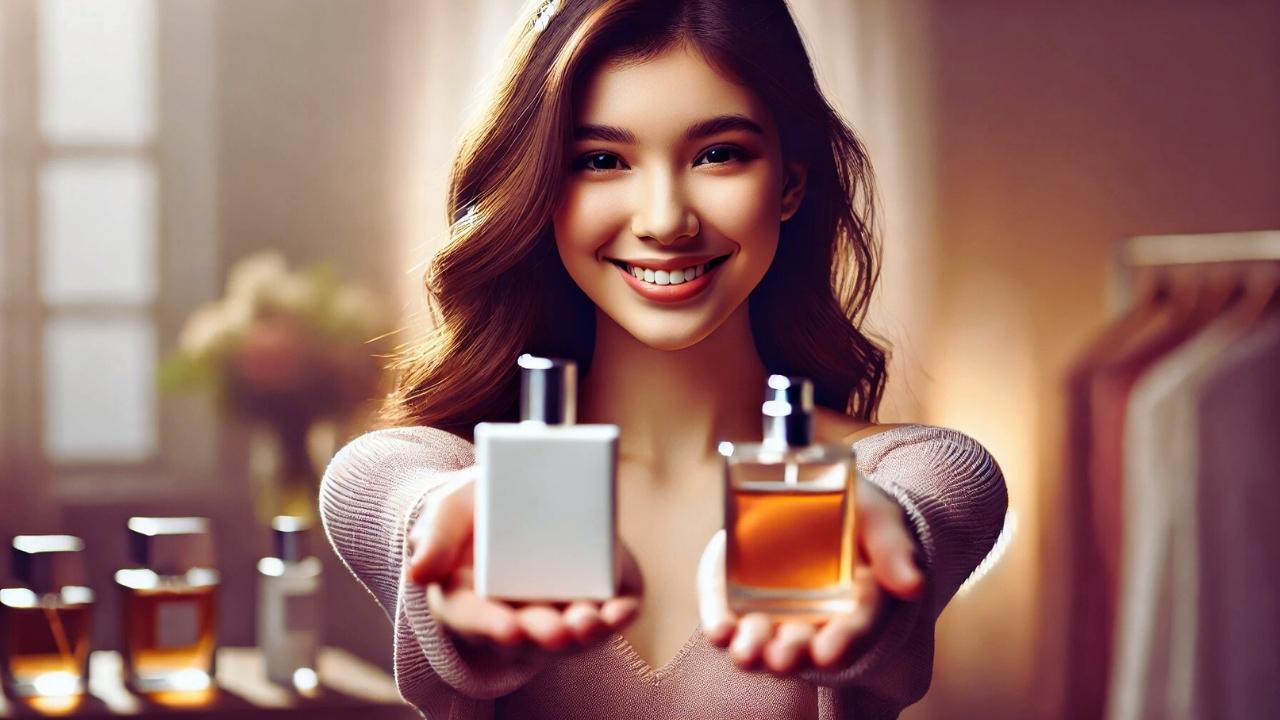I love exploring the world of fragrances. I notice many people ask, “What is the difference between perfume and cologne?” I see a lot of confusion about eau de toilette, eau de parfum, and many other terms. We use these labels every day, yet we rarely understand their history or their impact on personal expression.
A Brief History
Fragrance blends date back thousands of years. Ancient civilizations used oils and resins during ceremonies. Over time, perfumers refined techniques to capture scents from flowers and herbs. That evolution led to products like cologne in 18th-century Europe. People soon realized scents shaped personal style.
Why Fragrances Matter
I believe fragrances do more than smell good. I wear scents to express my mood. Some prefer strong aromas that last all day. Others like a subtle mist to enhance personal care routines. Scents often mark our identity. You might recall how a friend or family member smells. This emotional bond makes perfume and cologne special.
Perfume vs. Cologne: What is the Difference Between Perfume and Cologne?
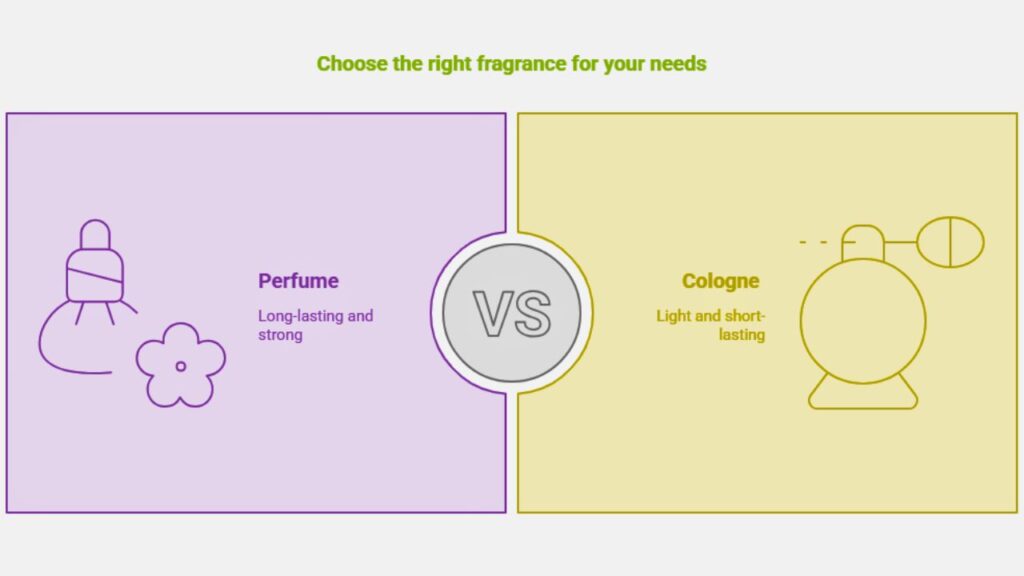
When people ask, “What is cologne and perfume difference?” they usually refer to fragrance oil concentration. Perfume (also called parfum) typically has a higher concentration of aromatic oils. Cologne has a lighter concentration. That difference affects strength and longevity. Perfumes can last up to eight hours or more. Colognes might last around two to four hours. This is a broad guideline because skin type, weather, and application also matter.
The Role of Eau de Toilette and Eau de Parfum
I see many questions like “What difference between eau de toilette and perfume?” or “What is stronger cologne or eau de toilette?” These categories exist between the extremes of cologne and pure parfum. Eau de toilette (EDT) usually has moderate oil concentration. Eau de parfum (EDP) has a bit more. EDP tends to last longer than EDT. Yet, some people enjoy EDT because it feels lighter on the skin.
Personal Care and Expression
I view my fragrance as part of my grooming routine. I also consider the emotions behind each scent. A spicy cologne can give me confidence. A floral perfume might give me a softer aura. Fragrances match different occasions. A strong EDP might overwhelm a casual outing. A gentle EDT feels more versatile.
You can find more inspiration by checking out my thoughts on A Thousand Wishes Perfume. You might also enjoy learning about cologne spray spots if you want to apply scents effectively.
I recommend paying attention to your personal preference. Look for a scent that tells your story. You might realize you prefer a soft body mist or a powerful eau de parfum. The key is to explore, test, and enjoy.
Basic Definitions of Perfume & Cologne
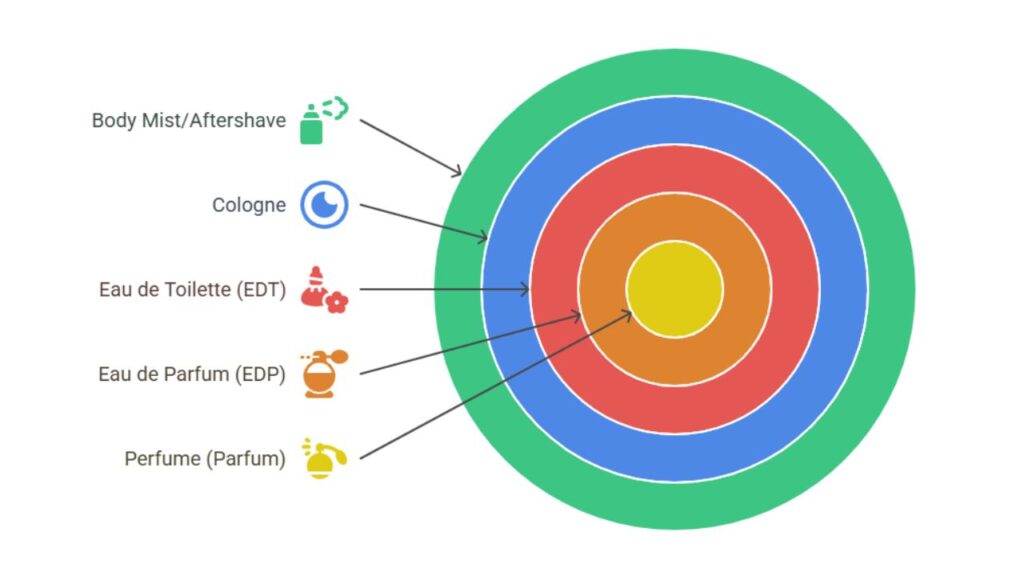
I see so many fragrance terms. Let’s define them step by step to answer questions like “What does toilette mean in perfume?” or “What does EDP mean in perfume?” Clear definitions can help us pick the right product.
Perfume (Parfum)
Perfume or parfum has the highest concentration of aromatic oils. This can range from 20% to 30%. Perfume tends to offer strong sillage and extended longevity. When people ask, “What is the difference between perfume and fragrance mist?” I point to oil content. Perfume uses higher oil percentages. Mists contain less.
Cologne
Cologne usually has a lighter concentration. Some refer to cologne as a men’s fragrance. That is a marketing tradition. Cologne’s oil content often falls between 2% to 5%. It feels refreshing but fades faster. Some wonder, “What does EDP mean in cologne?” EDP cologne is simply a marketing name for a higher-strength men’s fragrance. It sits closer to an eau de parfum level.
Eau de Toilette (EDT)
Eau de toilette typically holds around 5% to 15% oil concentration. People often ask, “What does toilette mean in cologne?” The word “toilette” originates from French for “getting ready.” EDT offers moderate longevity. It appeals to those who prefer a balanced scent. You might ask, “What is stronger eau de toilette or cologne?” EDT usually outlasts most colognes.
Eau de Parfum (EDP)
EDP has a higher concentration than EDT. It usually contains around 15% to 20% aromatic oils. EDP suits those who want a potent scent without the intensity of pure parfum. You might see questions like “What does EDP mean in perfume?” or “What is eau de parfum meaning?” Both point to the same concept: a strong, lasting fragrance.
Other Terms
- Body Mist or Body Spray: These have low oil content and feel very light. People often ask, “What is difference between body spray and perfume?” The main difference is the lower concentration in a spray or mist.
- Aftershave: Used post-shave to soothe skin. It has mild scent properties. If you ask, “What is the difference between aftershave and perfume?” the biggest difference is aftershave often contains skin-soothing ingredients like witch hazel or aloe.
Each term describes a unique strength. I suggest remembering these definitions. Then, you can answer “What is difference perfume and toilette spray?” or “What is cologne vs perfume?” with confidence.
The Spectrum of Fragrance Strength

I like to think of fragrances on a scale. On one end, we see light forms like body mists. On the other end, we see potent extracts like parfum. People often ask, “What is the difference between cologne and eau de toilette?” or “What is the difference between fragrance and perfume?” The answer lies in oil concentration and lasting power.
Cologne (Eau de Cologne)
Eau de cologne, also called cologne, hovers at around 2% to 5% fragrance oil. This strength offers a quick burst of scent. You might wear cologne when you want a fresh feel. If you wonder, “What is the difference between cologne and toilet water?” both contain lower oil percentages than perfume. The naming varies by region.
Eau de Toilette (EDT)
EDT provides a step up in potency. It usually contains around 5% to 15% oil. People enjoy EDT because it offers a noticeable scent without lingering all day. If you ask, “What is stronger eau de toilette or cologne?” the EDT usually wins. It sticks around longer.
Eau de Parfum (EDP)
EDP is more robust. Its oil content runs around 15% to 20%. People who enjoy deeper sillage often pick EDP. You might see questions like “What is difference eau de toilette and eau de parfum?” The difference lies in how long they last. EDP tends to remain on the skin for six hours or more, depending on skin chemistry.
Parfum (Perfume)
Parfum or pure perfume is at the top. It might have 20% to 30% oil content. Some pure parfums go even higher. If you see “What is stronger toilette or parfum?” the answer is parfum. It packs the most longevity and sillage.
Body Mist and Body Spray
Body mists and sprays contain minimal fragrance oil. They give a gentle aroma. If you ask, “What is difference between mist and perfume?” you will notice that perfume has a stronger formula. Mist is fleeting and needs frequent re-application.
You may browse cologne or EDT if you want a moderate scent for everyday wear. If you crave stronger projection, EDP or perfume might suit you better. I suggest trying different formulas to see how your skin reacts. My friend loves eau de toilette because she finds pure perfume overwhelming. I think fragrance choice is personal and depends on how you feel at the moment.
Comparisons and Differences
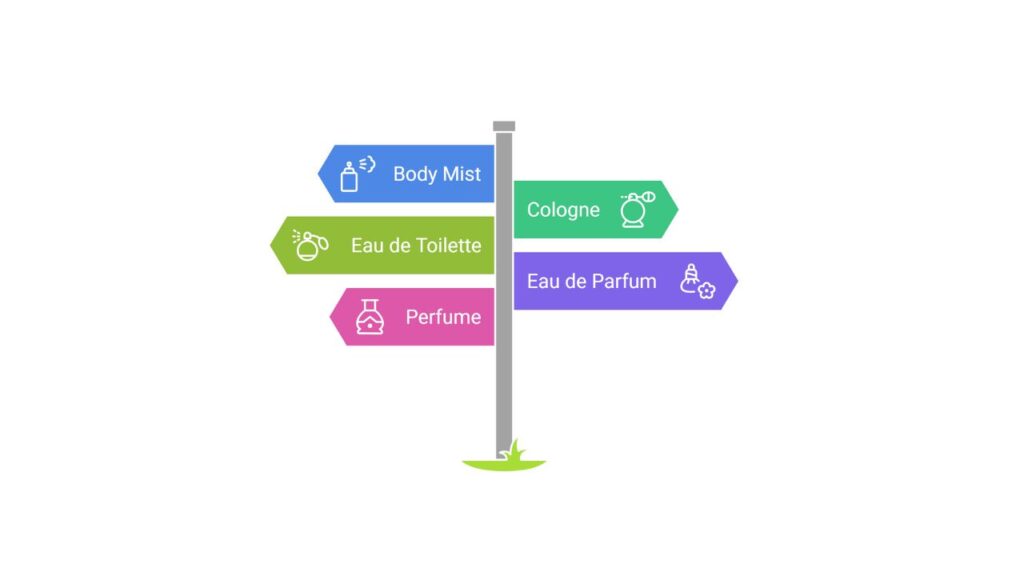
People always ask me to compare perfume vs. cologne, eau de toilette vs. parfum, or body mist vs. perfume. I created a simple comparison table for clarity.
| Type | Oil Concentration | Longevity | Primary Use Case |
|---|---|---|---|
| Body Mist | 1–2% | ~1 hour | Light freshness after shower or workout |
| Cologne | 2–5% | ~2–4 hours | Quick boost of scent, often marketed to men |
| Eau de Toilette | 5–15% | ~3–5 hours | Daily wear, moderate scent profile |
| Eau de Parfum | 15–20% | ~5–8 hours | Longer-lasting, more intense than EDT |
| Perfume (Parfum) | 20–30% | ~8+ hours | High-end, intense, and very long-lasting |
This chart addresses many common questions. For instance, “What is difference between body spray and perfume?” becomes clear. The lower oil content in body spray or body mist offers a softer aroma. Perfume or eau de parfum projects more.
Perfume vs. Cologne
I see the question, “What is the difference between a cologne and perfume?” Perfume has more oil. Cologne has less. Perfume usually costs more. Cologne is quick to fade. Some call cologne a men’s fragrance. Modern perfumers release cologne versions for women too.
Eau de Toilette vs. Parfum
Eau de toilette is lighter. Parfum is heavier. The difference in concentration explains, “What is difference between toilette and parfum?” Parfum has more aromatic oils. That means more power and longer wear.
Body Mist vs. Perfume
Body mist or body spray can refresh your skin. Perfume can linger and create a signature aura. The difference in longevity answers, “What is difference between scent and perfume?” Perfume sits on top, while a mist feels like a gentle layer.
I usually decide based on occasion. If I attend a wedding, I wear eau de parfum or parfum. If I run errands, I reach for cologne or a body mist. I enjoy variety. I love how each fragrance type has its own personality.
Special Terms Explained
I get a lot of questions about terms like EDP (Eau de Parfum), EDT (Eau de Toilette), and “toilette.” Let’s clarify these words once and for all.
EDP (Eau de Parfum)
EDP usually contains 15% to 20% fragrance oil. When someone asks, “What does EDP mean in perfume?” the answer is simple. It stands for Eau de Parfum, a popular choice for those who want a balance of strong scent and fair longevity. It suits daily wear and special events.
EDT (Eau de Toilette)
EDT contains around 5% to 15% fragrance oil. People ask, “What is the difference perfume and toilette spray?” The difference is that EDT usually offers a milder scent. It won’t overpower a room. Some wonder, “What does toilette mean in perfume?” The term comes from French for “toilette,” meaning a grooming process. It fits the idea of a daily pick-me-up fragrance.
“Toilette” Meaning
This word puzzles many people. They see “Eau de Toilette vs. cologne” or ask, “What does toilette mean in cologne?” It signals a refreshing strength level rather than a purely heavy formulation. EDT suits everyday use and feels comfortable on the skin.
EDP in Cologne
Brands sometimes label men’s fragrances as EDP. People ask, “What does EDP mean in cologne?” It means that men’s cologne contains more oil than a typical cologne formula. It lasts longer and projects more.
Why Know These Terms?
If you understand EDP, EDT, and toilette, you can answer queries like, “What difference between eau de toilette and perfume?” or “What is the difference between eau de parfum and cologne?” Knowledge helps you compare scents. I always read the label before purchasing. I also love to test the fragrance on my wrist to see how it evolves.
I recommend making a small list of terms and definitions. Then, you can pick the perfect scent without feeling lost at the store. You might also visit A Thousand Wishes Perfume for more insights on fragrance styles.

The Decision-Making Guide
I often receive questions about which fragrance to buy. People ask, “What is better cologne or perfume?” or “What is better eau de toilette or cologne?” The answer depends on several factors. Let’s break them down:
Occasion Matters
I consider where I plan to wear the scent. I prefer a subtle fragrance at the office. Eau de toilette might suit that scenario. If I attend a party, I want something bolder, like eau de parfum or even pure perfume.
Casual Daytime
When I run errands, I choose lighter scents. If someone asks, “What is better cologne or eau de toilette?” I often say cologne feels simpler for day-to-day tasks, but an EDT can add a bit more dimension.
Evening Events
An evening event sometimes calls for a statement fragrance. “What is better eau de parfum or toilette?” I lean toward eau de parfum at night. It offers stronger projection and can last through the event.
Personal Preference
We all have different tastes. I like floral scents, while my friend prefers woody notes. If you love strong perfume but find it too intense for daily wear, you might store it for special occasions. Some people wonder, “What is difference between spray and perfume?” or “What is difference between fragrance and perfume?” Perfume specifically refers to the higher oil concentration. “Spray” can just mean the delivery method (a spray bottle).
Skin Type
My skin type affects how scents perform. Dry skin often holds fragrance for a shorter time. Oily skin can make scents last longer. People who have dry skin sometimes layer lotion or body cream before applying perfume. That helps the scent cling to the skin. If you have ever asked, “What is the difference between perfume and perfume oil?” you might enjoy an oil-based fragrance if you have dry or sensitive skin.
Season and Climate
Hot weather can intensify scents. I switch to lighter cologne or EDT during summer. In cold weather, heavier perfumes project less, so I might use EDP or parfum. If you wonder, “What is stronger eau de toilette or cologne?” EDT can feel too strong in extreme heat. But in winter, it feels just right.
Longevity vs. Projection
Some people focus on how long a fragrance lasts. Others want how far the scent travels (known as sillage or projection). Perfume and EDP usually last longer. Cologne and body mist fade faster. If you want an all-day aroma, perfume might be best. If you prefer something that doesn’t linger, try cologne or a body spray.
Cost and Budget
Perfume often costs more because of its higher oil content. Cologne or EDT is cheaper to produce. You might see two versions of the same scent: an EDP and an EDT. The EDP likely costs more. If you’re on a budget, you might choose the EDT. Some wonder, “What is the difference between a tester cologne and regular?” Testers contain the same juice. The packaging might differ.
Tips for Making a Choice
- Test on Your Skin: Never rely on paper strips alone. Body chemistry changes the scent.
- Wait and See: Let the fragrance dry down for 30 minutes. The middle and base notes reveal themselves over time.
- Consider the Occasion: Ask yourself when and where you’ll wear it.
- Think About Seasons: A rich scent might feel cloying in summer.
- Sample Before Buying: Many stores offer samples. Some brands sell travel sizes.
Example Scenario
A friend asked me, “What is better perfume or cologne for a first date?” I suggested a mild eau de toilette or a fresh cologne. It doesn’t overwhelm your date. It feels inviting and approachable. Another friend asked, “What is better eau de parfum or toilette for a wedding?” I said eau de parfum might work well. It will last through the ceremony and reception.
You can also read more about proper application techniques in my post about cologne spray spots. I discuss where to spray so you get the best performance with minimal waste.
In the end, your choice depends on comfort, occasion, and desired effect. I think exploring these options is half the fun. If you love variety, you might own an EDT for daytime and an EDP for nightlife. If you only want one bottle, I suggest a balanced eau de parfum that fits many settings.
Product Types Beyond Basic Fragrances
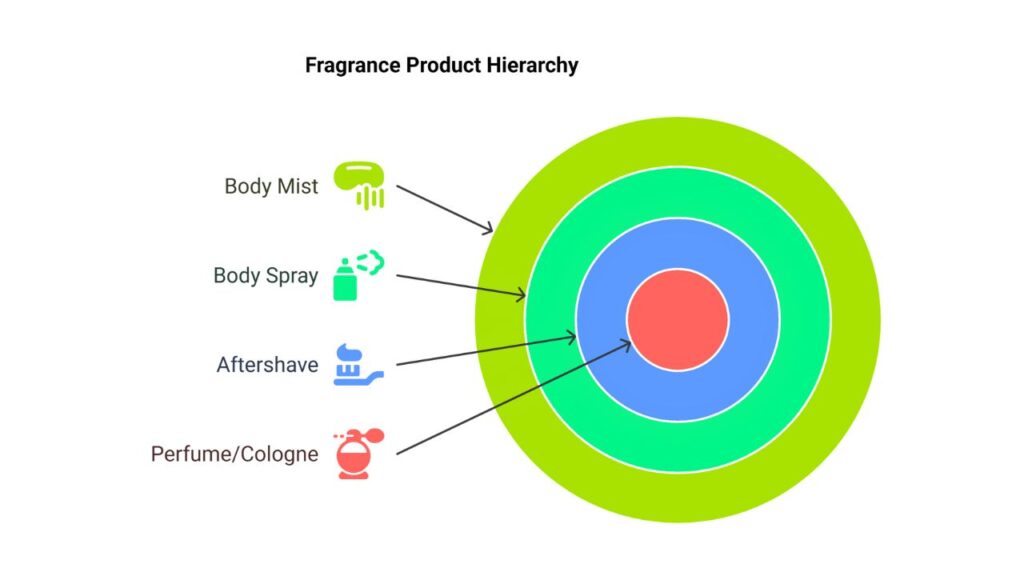
Fragrance isn’t just about perfume, cologne, and eau de toilette. Other products like body mist, body spray, and aftershave play a big role in personal care. People often ask, “What is difference between body mist and perfume?” or “What is difference between after shave and cologne?” Let’s look closer.
Body Mist
Body mist has a very low oil concentration. It feels refreshing and light. I enjoy it after a shower or workout. It usually lasts about an hour or so. If you want a subtle scent, body mist helps. It’s cheaper than perfume. For some, that answers “What is difference between body spray and perfume?” Perfume is stronger, while body spray is lighter and more fleeting.
Body Spray
Body spray is similar to a mist. Some brands label them interchangeably. A spray may include deodorant properties. If you need to freshen up on the go, body spray works well. I sometimes keep one in my gym bag.
Aftershave
Aftershave soothes the skin post-shave. It often contains antiseptic agents. People ask, “What is the difference between aftershave and cologne?” or “What is the difference between aftershave and perfume?” Aftershave focuses on skin relief. Cologne or perfume focuses on aroma. Aftershave has a lighter scent, so it won’t last as long as cologne.
Ideal Usage
I like to use a body mist or spray when I want a quick refresh. I apply aftershave after shaving to calm skin. For a more lasting fragrance, I reach for cologne, EDT, or perfume. If you plan to layer scents, start with something light like a mist. Then apply a matching perfume for extra depth.
Gender Differences in Fragrances
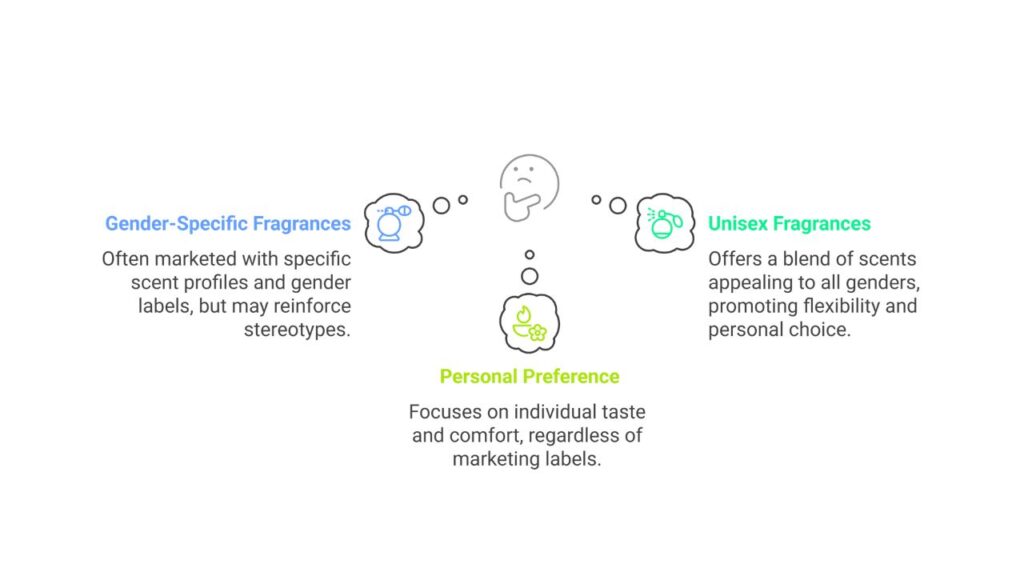
I see so many labels: men’s cologne, women’s perfume, unisex fragrance. People ask, “What is the difference between men and women perfume?” Scent marketing often relies on gender stereotypes. Floral or sweet notes sometimes target women. Woody or musky notes aim at men. The truth is more flexible.
Men’s vs. Women’s Fragrances
A men’s product might emphasize “cologne” on the label. It might contain notes like cedar, leather, or spices. Women’s scents may highlight florals, fruits, or gourmands. That doesn’t mean a woman can’t wear a woody fragrance or a man can’t wear a floral. I often choose what smells good to me, regardless of the label.
Unisex Options
Some brands release unisex or gender-neutral fragrances. They might blend citrus, woods, or soft florals. These scents appeal to anyone who likes the combination. People ask me, “What is cologne vs perfume?” They assume cologne is for men, perfume is for women. That’s just marketing tradition. The real difference lies in oil content and style, not gender.
Personal Choice
I believe fragrance doesn’t need a gender label. If you like how it smells, wear it. If you find a unisex fragrance that fits your personality, go for it. The main question is whether it feels like you. Ask yourself if you want something strong or light, floral or spicy. The rest is just branding.
Niche vs. Designer Fragrances
You might see “niche” or “designer” mentioned in fragrance discussions. People ask, “What is the difference in perfume and cologne from niche vs. designer?” Let’s break that down.
Designer Fragrances
Designer brands like Chanel, Dior, or Armani create popular scents. They often focus on broader appeal. They distribute worldwide in department stores. These scents can be eau de toilette, eau de parfum, or even cologne versions. They cost less than many niche scents. The brand invests in marketing to reach a wider audience.
Niche Fragrances
Niche brands specialize in unique or high-quality ingredients. They aim for artistic expression. You might ask, “What is the difference between niche and designer?” Niche fragrances often use rare materials. They sometimes have unusual notes that you won’t find in mainstream releases. Niche brands often produce fewer bottles. This exclusivity can raise prices.
Market Target, Scent Uniqueness, Pricing
Niche fragrances target perfume lovers who crave distinctive scents. Designer fragrances target a broad market that wants a recognizable brand name. Niche bottles sometimes cost more because of their small production runs. Designer scents have bigger marketing budgets. This can make them more accessible.
My Perspective
I enjoy both types. Some days, I grab a well-known designer EDT. Other days, I enjoy a niche EDP that smells like nothing else. I suggest testing both if you ask, “What is better cologne or perfume from a niche house?” The answer depends on your budget and preference. Niche might feel exclusive. Designer might feel more versatile. You can explore both to find your signature scent.
Understanding Fragrance Strength and Longevity
I often see confusion around terms like “stronger,” “longer-lasting,” or “more powerful.” When people ask, “What is the difference between EDT and EDP in perfume?” they usually want to know about strength and wear time.
Concentration vs. Strength
Perfume concentration (oil percentage) influences how strong a fragrance smells. Parfum or pure perfume ranks at the top. Cologne (eau de cologne) sits near the bottom. If you see “What is stronger cologne or eau de toilette?” EDT is usually stronger. That’s because it has more oil. However, strength also depends on the fragrance notes.
Longevity
Longevity refers to how long the scent remains noticeable on your skin. Higher concentrations often last longer. I see questions like, “What is stronger eau de toilette or cologne?” or “What is the difference between eau toilette and perfume?” Perfume usually provides longer wear. Yet, your body chemistry and environment also matter. Hot weather can cause scents to disperse quickly. Cooler weather might prolong them.
“Stronger” in Context
“Stronger” can mean different things. Some folks measure strength by how far the scent travels (sillage). Others see it as the total hours the scent remains. You might ask, “What is difference between toilette spray and perfume?” The perfume has more oil, so it might be “stronger.” That doesn’t mean you always want maximum intensity. Sometimes, a gentle fragrance suits better.
Tips for Maximizing Strength
- Apply on Moist Skin: Hydrated skin holds scent better.
- Use Pulse Points: Neck, wrists, inside elbows.
- Layer: Use matching lotion or shower gel if available.
- Don’t Overdo It: A potent EDP can overwhelm if you spray too much.
You can explore cologne spray spots for more tips on placement. I like to spray behind my ears when I want others to catch a subtle whiff.
The Importance of Testing and Sampling
I always tell friends to try testers or samples before buying a full bottle. People ask, “What is the difference between US tester and original perfume?” Testers are typically the same fragrance in a plain box. They’re meant for in-store testing. The scent is identical.
Why Test?
Scents evolve on skin. The top notes might smell amazing, but the middle or base notes might not suit you. If you see a fragrance you love on paper, test it on your wrist. Wait 30 minutes. See if you still enjoy it.
Samples and Decants
Some stores provide small vials. This lets you wear the fragrance for a day or two. Online retailers sometimes offer decants. You might ask, “What is the difference between EDP and EDT perfumes for me?” The best way to find out is by trying them. You’ll see if you prefer the heavier or lighter version.
Common Questions
I hear, “What is the difference between a tester cologne and regular?” or “What is the difference from perfume and toilette spray in sample form?” The main difference is packaging. Sometimes, testers don’t include fancy caps. The fluid inside remains the same.
Purchase Decision
After sampling, you know how a fragrance performs on your skin. You can figure out if it’s worth the price. Sampling answers “What is the difference in perfume and cologne for me personally?” because you’ll see how each interacts with your body chemistry. That knowledge protects your wallet and avoids buyer’s remorse.
Aftershaves and Cologne: More Than Just Scent
Some folks ask, “What is the difference between after shave and cologne?” or “What is the difference between aftershave and perfume?” Aftershave goes beyond fragrance. It soothes and disinfects skin post-shave. Cologne focuses on scent alone.
Aftershave Benefits
Aftershave often contains alcohol or astringent ingredients. It helps close pores and reduce irritation. I see men using aftershave daily. They enjoy a light scent and skin benefits. However, aftershave scent usually fades fast. People who crave a stronger aroma might layer cologne or perfume on top.
Cologne’s Role
Cologne provides a splash of freshness. It can boost confidence. People often wonder if they should skip aftershave and go straight to cologne. I find that aftershave plays a vital role in skincare. Cologne can’t replace it. If you ask, “What is stronger cologne or aftershave?” cologne usually projects more because it has more fragrance oils.
Combining the Two
Some brands offer matching aftershave and cologne sets. You can apply aftershave first for skin benefits. Then, you can add a coordinating cologne. That approach creates a cohesive scent profile. It also keeps your skin comfortable.
I recommend aftershave if you shave regularly. If you just want fragrance, cologne or EDT might suffice. If you see “What is the difference between aftershave and cologne spray in daily use?” the biggest difference is function. Aftershave calms skin. Cologne projects a pleasant aroma.
Understanding Fragrance Notes and Composition
Fragrances usually contain three layers of notes: top, middle, and base. People often wonder, “What is difference between scent and perfume?” Scent refers to the overall aroma. Perfume is a product that includes these layers.
Top Notes
Top notes appear immediately upon spraying. They create the first impression. Citrus, light florals, or herbal notes often pop up here. You might love a scent at first spray because the top notes smell sweet or bright. They usually fade in 15 to 30 minutes.
Middle (Heart) Notes
These notes form the core of the fragrance. Florals, spices, or green notes appear here. They unfold after the top notes fade. If you ask, “What is the difference in perfume and eau de toilette in terms of notes?” the heart might smell similar, but the intensity differs. EDT has a lighter overall profile.
Base Notes
Base notes ground the scent. Musk, woods, vanilla, or amber often rest here. These notes come out after an hour or so. They remain the longest on your skin. When people ask, “What is difference between parfum and perfume?” or “What difference between eau de toilette and perfume?” I explain that pure perfume tends to have richer base notes that last longer.
Composition
Fragrances combine all three note layers. Scent changes over time. That’s why sampling is vital. You might hate the top notes but love the dry-down. Or the top might wow you, but the base might not resonate. Understanding these stages helps you appreciate fragrances on a deeper level.
The Evolution of Fragrances
We sometimes forget how perfumes and colognes have changed throughout history. People used to rely on natural oils and extracts. Modern fragrances might blend natural notes with synthetic ingredients. When I see questions like, “What is the difference between fragrance and perfume in historical context?” I note how older perfumes had fewer synthetic elements.
Historical Evolution
Ancient Egypt, Greece, and Rome prized scented oils. Perfume signified luxury. Over centuries, perfumers discovered distillation and extraction. Medieval Europe embraced floral waters. Then, Eau de Cologne was born in the 18th century.
Synthetic vs. Natural Ingredients
Synthetic materials became popular in the late 19th century. Perfumers found ways to replicate rare scents. That reduced cost and allowed for new creations. Some consumers prefer natural blends. Others appreciate the creativity in synthetics. If you wonder, “What is the difference from perfume and toilette spray in older times vs. now?” the older formulas might have used fewer lab-made molecules.
Modern Preferences
Today, brands focus on sustainability and transparency. Many produce vegan or cruelty-free fragrances. Some want organic certifications. I enjoy trying both classic and contemporary scents. If you love old-school perfume houses, you might find vintage compositions. If you want a modern twist, you can explore niche lines that blend synthetic musks or unusual accords.
Future Trends
I see more interest in eco-friendly packaging and ethically sourced ingredients. Some folks want local, handmade fragrances that rely on natural essential oils. Others love high-tech molecules that create unique aromas. This diversity keeps the perfume world exciting. I can’t wait to see what comes next.
Frequently Asked Questions (FAQs)
Below, I answer some of the most common questions I hear about fragrances.
Q1: What is the difference between perfume and cologne spray?
Perfume spray often has a higher oil concentration than cologne spray. Perfume lasts longer. Cologne feels lighter and fades quicker.
Q2: What is the difference between eau de toilette and perfume?
Eau de toilette has lower oil content (around 5% to 15%). Perfume (or parfum) can reach 20% to 30%. That difference gives perfume stronger, longer-lasting scent.
Q3: What does EDP mean in perfume and cologne?
EDP stands for Eau de Parfum. It usually contains 15% to 20% fragrance oil. When you see “EDP cologne,” it means a men’s fragrance with a higher concentration than typical cologne.
Q4: What is difference between body mist and perfume?
Body mist has a very low oil percentage. It smells fresh but evaporates fast. Perfume offers a rich, lingering scent.
Q5: What is the difference between a tester cologne and regular?
The scent formula is the same. The difference lies in packaging. Testers come in plain boxes. They might have “Tester” labels. Regular versions have the standard packaging.
Q6: What is stronger toilette or parfum?
Parfum is stronger. It usually has more concentrated oils than eau de toilette.
Q7: What is the difference in perfume and cologne for men and women?
Marketing often calls men’s scents cologne and women’s scents perfume. The true difference is oil concentration. Anyone can wear any fragrance.
Q8: What is difference between fragrance mist and perfume for daily use?
Fragrance mist offers a light effect. Perfume provides a lasting aroma. Mist works well if you want a quick refresh.
I hope these FAQs clear up confusion. If you still have questions, you can check my other articles, like A Thousand Wishes Perfume or my tips on cologne spray spots. Remember, wear what makes you happy.
